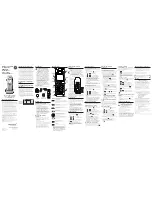
The detector will automatically enable the signal processing after 10 min-
utes.
T
esting the detector will activate the alarm relay and send a signal to
the panel.
CLEANING
Before removing the detector, notify the proper authorities that the smoke
detector system is undergoing maintenance and will be temporarily out of
service. Disable the zone or system undergoing maintenance to prevent un-
wanted alarms.
1. Remove the sensor to be cleaned from the system.
2. Remove the sensor cover by pressing firmly on each of the four removal
tabs that hold the cover in place. (See Figure 4.)
3. Vacuum the screen carefully without removing it. If further cleaning is
required continue with Step 4, otherwise skip to Step 7.
4. Remove the chamber cover/screen assembly by pulling it straight out.
5. Use a vacuum cleaner or compressed air to remove dust and debris from
the sensing chamber.
6. Reinstall the chamber cover/screen assembly by aligning the arrows on
the top with the two round-top posts on the sensing chamber, and gently
pressing it until it fits securely.
7. Replace the cover using the LEDs to align the cover and then gently push-
ing it until it locks into place. NOTE: Make sure that the thermistors do not
become bent under the cover.
8. Reinstall the detector.
9. Test the detector as described in TESTING.
10. Reconnect disabled circuits.
11. Notify the proper authorities that the system is back on line.
ABOUT CARBON MONOXIDE DETECTORS
CAUTION
CAUTION: This carbon monoxide detector is designed for indoor use only.
Do not expose to rain or moisture. Do not knock or drop the detector. The
detector will not protect against the risk of carbon monoxide poisoning if
not properly wired. The detector will only indicate the presence of carbon
monoxide gas at the sensor. Carbon monoxide gas may be present in other
areas.
This carbon monoxide detector is NOT:
• Designed to detect any gas other than carbon monoxide
• To be seen as a substitute for the proper servicing of fuel-burning appli-
ances or the sweeping of chimneys.
• To be used on an intermittent basis, or as a portable alarm for the spill-
age of combustion products from fuel-burning appliances or chimneys.
Carbon monoxide gas is a highly poisonous gas which is released when fuels
are burnt. It is invisible, has no smell and is therefore impossible to detect
with the human senses. Under normal conditions in a room where fuel burn-
ing appliances are well maintained and correctly ventilated, the amount of
carbon monoxide released into the room by appliances should not be danger-
ous.
SYMPTOMS OF CARBON MONOXIDE POISONING
Carbon monoxide bonds to the hemoglobin in the blood and reduces the
amount of oxygen being circulated in the body. The following symptoms are
examples taken from NFPA 72 and 720. They represent approximate values
for healthy adults:
Concentration (ppm CO)
Symptoms
200
Mild headache
after 2-3 hours of exposure
400
Headache and nausea
after 1-2 hours of exposure
800
Headache, nausea, and dizziness
after 45 minutes of exposure;
collapse and unconsciousness
after 2 hours of exposure
Many causes of reported carbon monoxide poisoning indicate that while vic-
tims are aware that they are not well, they become so disoriented that they
are unable to save themselves by either exiting the building or calling for
assistance.
Also young children and pets may be the first to be affected.
Per UL standard 2075, FIK-PC351 has been tested to the sensitivity limits de-
fined in UL standard 2034.
ALARM THRESHOLDS ARE AS FOLLOWS:
Parts Per Million
Detector response time, min.
70 ±5ppm
60-240
150 ±5ppm
10-50
400 ±10ppm
4-15
What to do if the carbon monoxide detector goes into alarm:
Immediately move to a spot where fresh air is available, preferably out-
doors.
IMPORTANT: This detector should be tested and maintained regularly fol-
lowing National Fire Protection Association (NFPA) 72 and 720 require-
ments.
CO SENSOR LIFETIME
The CO cell has an expected lifetime of approximately ten years. The detector
is programmed to signal the approach of end of this lifetime to the control
panel. The CO cell is not a field replaceable component. The smoke sensor
will continue to operate using the photoelectric sensing element even though
the CO cell is no longer operational. The CO detector will not operate once the
CO cell has reached its end of life.
SPECIAL NOTE REGARDING SMOKE DETECTOR GUARDS
Smoke detectors are not to be used with detector guards unless the combina-
tion has been evaluated and found suitable for that purpose.
3
I56-6638-000
1/15/2021






















